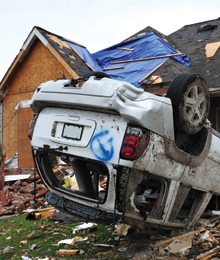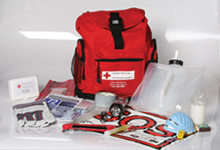In Case of Emergency
June 24, 2011 by Michael Hill
Filed under lifestyle
 As much as we might not like to admit it, disasters happen. And much like the provinces mentioned above, Ontario isn’t immune to perils – need I remind you of the tornado that struck Vaughan in 2009? In response to these recent calamities, John Saunders, the Canadian Red Cross’s provincial director of disaster management for Ontario, provides advice on how to best prepare for Canadian disasters and emergencies.
As much as we might not like to admit it, disasters happen. And much like the provinces mentioned above, Ontario isn’t immune to perils – need I remind you of the tornado that struck Vaughan in 2009? In response to these recent calamities, John Saunders, the Canadian Red Cross’s provincial director of disaster management for Ontario, provides advice on how to best prepare for Canadian disasters and emergencies.
“What we encourage people to do, first of all, is identify what the greatest risk that they are facing is,” says Saunders, who explains that in Ontario, this includes severe thunderstorms, tornadoes, flooding, snow and ice storms. Next, plan to meet in the safest place in your home. If a hurricane, tornado or severe blizzard hits, Saunders notes, “That would usually be as low as you can go, against the strongest wall, and away from any windows.” If localized flooding arises, it’s best to stay out of the basement for obvious reasons.
It’s also quite possible that you may be away from the home when an emergency ensues. In that case, Saunders suggests prearranging a meeting place – like a local school or community centre – so family members know where to congregate during a crisis. “Families are the best support service, and when families get separated, that causes a lot of unnecessary stress in an already stressful situation,” he adds.
Finally: the emergency kit. This should include essentials such as a first-aid kit, food, water, blankets, and a crank radio and flashlight to avoid the need for batteries. Should your home become damaged or isolated by flooding or snow, for example, your emergency kit will sustain you. At minimum, there should be enough supplies for 72 hours. “Without fail, it’s the individuals who are better prepared that are the ones who seem to bounce back quickest,” says Saunders.
and flashlight to avoid the need for batteries. Should your home become damaged or isolated by flooding or snow, for example, your emergency kit will sustain you. At minimum, there should be enough supplies for 72 hours. “Without fail, it’s the individuals who are better prepared that are the ones who seem to bounce back quickest,” says Saunders.
For more tips on preparedness and a listing of its public education campaigns, visit the Red Cross website. Because, as Saunders concludes, “If you look at the number of Canadians currently suffering as a result of natural disasters, from forest fires to flooding, these things do happen in Canada and we can’t just preserve the idea that they never will, which is why preparedness is so important for everybody to take seriously.”
www.redcross.ca
The Red Cross Disaster Preparedness Kit contains:
1 wind-up flashlight/radio/alarm (no batteries required)
1 50-hour candle
1 Multi-function knife
1 S.O.S. sign
1 Emergency rescue blanket
1 Emergency Preparedness Guide
20 Water purification tablets
2 Biohazard waste bags
1 Whistle
1 Pair of work gloves
1 12-hour light stick
1 First-Aid kit
1 Emergency plastic sheeting
1 Duct tape
2 Dust masks
1 Nylon backpack







Comments
Feel free to leave a comment...
and oh, if you want a pic to show with your comment, go get a gravatar!